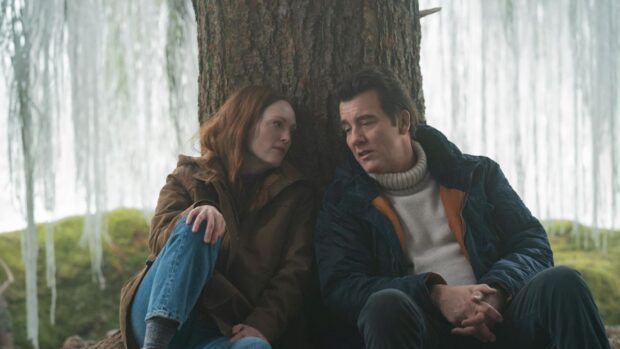Welcome back to the feature column that explores Stephen King’s books in the order they were published…sort of! Except this one, read out of order to tie in with the release of the new Apple TV+ series.
WARNING: you can’t tell a full story without spoilers.
There’s often a feeling that all of Stephen King’s strongest characters are some variation of male writers. This isn’t true: some of them are wives of writers.
Flippancy aside, 2006’s LISEY’S STORY is one of a handful of King’s novels written specifically from a strong female perspective. In the tradition of Rosie McClendon (Rose Madder), Jessie Burlingame (Gerald’s Game) and the titular Dolores Claiborne — the spousal Avengers of the King Literary Universe — here King introduces us Lisey Landon, the recently widowed wife of the famous novelist Scott Landon.
Reflecting on his own recent illness, King’s inspiration was allegedly imagining what his studio would look like when he was dead, and the things his own wife Tabitha would have to go through. In the novel, the titular Lisey (pronounced ‘Lee-see’) is still going through her late husband’s manuscripts two years after his passing. Academics and fans alike are pressuring her to release unpublished material, and one scholar is particularly persistent.
“To the public eye, the spouses of well-known writers are all but invisible, and no one knew it better than Lisey Landon.”
Enter Zack McCool. At least that’s what he calls himself. Hired by that one academic to muscle Lisey into submission, he becomes an unstoppable force unable to be called off. The remainder of the book is not just Lisey fending off “Zack’s” attacks, but also recalling memories she’s either repressed or forgotten. A major one is the memory of her saving Scott from a near-fatal shooting by a crazed fan. Others are how Scott’s family history of mental illness has manifested, either through violent mania (what he calls a “bad bool”) or a deep state of catatonia. Sometimes these memories are so painful she’ll break off mid-thought and move onto something else.
Scott’s abusive relationship with his father emerges, along with the tragic fate of his brother. Lisey’s begins to find connections with with her older sister Amanda, insitutionalised after the latest of several suicide attempts. One of those connections is another world that Scott called the “Boo’ya Moon,” a place that served as both a literal “pool” on inspiration and a source of healing. Lisey discovers, or perhaps remembers, that Scott’s habit of bouncing back from gunshot wounds was his ability to travel to this other world.
“SOWISA, babyluv. You’re bound for the rabbit-hole, so strap it on nice and tight.”
Another backbone of the book is the secret language that couples and families share. At this stage in his life, King had been married to Tabitha for 36 years, so there’s a great deal of the duo in Scott and Lisey. Shorthand phrases and keywords serve as totemic markers and clues throughout the book, most significantly “bool,” “yum-yum tree” and the repeated mantra of SOWISA (or ‘Strap On Whenever It Seems Appropriate’). There’s a point where it feels as though great swathes of the text are glancing off your eyeballs, and the secret language becomes an impediment. Yet King ultimately pays this off with a firm message about the importance of spousal secrets.
Sharp-eyed Constant Readers will instantly see a thematic connection to previous King works. In The Talisman and Rose Madder, the protagonists of those books visit a parallel plane in times of trouble. Indeed, The Talisman‘s Territories are mentioned here. (Rose Madder is also a tale of a wife and her husband, although Rose McClendon’s attacker is closer to home). Similarly, East Stoneham, Maine appears here as well as Wolves of the Calla and Song of Susannah. Of course, the whole thing takes place near Castle View, and Deputy Andy Clutterbuck (The Dark Half, Needful Things) appears due to Sheriff Ridgewick being on his honeymoon.
At the time of writing, five episodes of director Pablo Larraín’s (No, Ema) eight-part adaptation have been released on Apple TV+ — and so far it’s pretty good. Created as more of an artistic interpretation of a horror thriller, it further proves the universality of King’s themes of spousal secrets and personal resilience.
During the production of the Under the Dome series, King categorically stated that LISEY’S STORY was his favourite of his published novels. It certainly feels like one of the most personal, and ultimately one of the most rewarding. As King mentions in the author statement for the book, “there really is a pool where we…go down to drink and cast our nets.” By the time we reach the end of this deceptively layered novel, we get the sense that King has let us have a small sip of that liquid inspiration.
Next time, it’s back to irregular programming with Rose Madder, a novel where King combines domestic horror with Greek mythology, nods to the Dark Tower saga — not to mention some connections with Lisey’s Story! While you’re here, go check out Batrock.net, where my buddy Alex Doenau is running through this Stephen King adventure with me.






